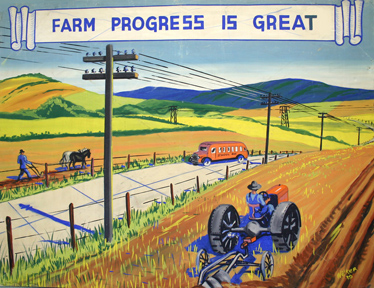MURALS, MURALS ON THE WALL: Depression-Era Art Still Tells Agriculture

If any artistic work could be described
as an attic treasure, it is the 10 murals
comprising the Historical Panorama of
Alabama Agriculture.They were conceived and executed
as little more than stage art — brightly
colored backdrops for the farm pavilion
at the five-day 1939 Alabama State Fair
— painted by a young WPA artist, John
Augustus Walker, struggling to balance
his moonlighting passion for art with a
demanding day job.Underscoring the project’s fleeting
nature, the murals were painted with
tempera, a water-based and less durable
medium, rather than Walker’s preferred
medium of oils.They were conceived with two goals
in mind: to show state fair goers how agriculture
started and developed and, most important, how scientific
farming methods were securing innovations and
improvements despite the challenges stemming from
Great Depression.Neither Walker nor the others who conceived and
executed the murals could have imagined what the
murals have become: a tangible 21st century link to
one of the most tumultuous chapters of Alabama’s
economic and agricultural heritage.At the fair’s conclusion, the paintings were
returned to Auburn University, stored in the attic of
Duncan Hall, headquarters of Alabama Cooperative
Extension, which had commissioned the paintings, and
largely forgotten.End of story — at least, for the next half century.A brief flurry of interest followed the murals’ rediscovery
and restoration in the mid-1980s — then back
to the same attic where they might have languished
another half century but for another rediscovery in the
early 1990s by Extension Art Director Bruce Dupree.Encountering the murals, Dupree recalls being
seized by one overriding thought. “I wanted to find a better place for them, even if
that involved taking them home with me if no other
place could be
found,” he says.Other professional
demands
intervened, and the
murals
were again forgotten.Years passed until 2006, when Dupree and other
members of the Extension Communications staff were
searching for a creative way to illustrate Cooperative
Extension’s role in Auburn University’s history during
the university’s Sesquicentennial celebration.That’s when Dupree was seized by another idea:
to use the murals to tell Extension’s story — an effort
endorsed by his boss, Dr. Carol Whatley, Extension’s
director of Communications and Marketing, who was
instrumental in securing a permanent home for the
murals at Auburn University’s Jule Collins Smith
Museum of Fine Art earlier this year.Fortunately for Dupree, Walker’s almost obsessive
record keeping provided him with his own tangible
link to the past.”That is one of the amazing facets of this story
— they (Walker and his wife) didn’t throw anything
away.” Dupree says. “It may have been because he
was a clerk or because of his personality — or because
WPA artists had to keep careful track of every postage
stamp, every paintbrush purchased.”With these records and others compiled by Auburn
University’s Special Collections and Archives, Dupree
managed to reconstruct the motivations leading up to
the exhibit.As he discovered, serendipity played a major role
in the events. The effort essentially grew out of desperation
on the part of Warren Leech, coordinator ofAlabama fair exhibits, who was looking for a way to replace 67 county displays with a consolidated exhibit. For assistance, he turned to Alabama Extension, then a major force in fair exhibits.He quickly won over Alabama’s hard-driving
Extension director, P.O. Davis, who envisioned a
series of paintings to underscore the role scientific
methods had played in advancing farming and Extension’s
role in advancing them.If a single mural best expresses Davis’s abiding
faith in scientific farming, it’s the tenth mural, featuring
a cornucopia of farm goods, Whatley says.
“Basically, it illustrates that we have this cornucopia
because we’ve learned how to produce food in
ways that bring more goods and services and more
civilization into people’s lives,” she says.
“That’s what Extension has always done — helped
people learn to do things more efficiently so their
lives can be better.”In September 2006, using the murals as a backdrop,
Dupree shared the panorama’s history with a
packed gallery of Auburn alumni, history buffs and
arts students as part of Auburn’s Sesquicentennial
Lecture Series.Following the Sesquicentennial, Dupree and Whatley
hoped the paintings would quickly find their way
into other shows, but the paintings needed restoration
and conservation before they were ready to travel.Last Nov. 7 until Dec. 31, the murals became the
centerpiece of a Birmingham Historical Society exhibit
at the Birmingham Public Library titled “Murals,
Murals on the Wall: Our Story through Art in Public
Places, 1929-1939,” highlighting Alabama WPA artists’
work.So what accounts for this growing appreciation for
the murals? While conceding that nostalgia certainly
plays a role, Whatley suspects the murals may fill a
deeper psychological need, providing viewers with a
sense of focus and perhaps of rootedness in the aftermath
of the 2008 Stock Market crash.”It may partly explain why people are so interested
in this now. We’ve had a wakeup call, and we’re
looking back to learn what earlier generations did in
hard times.” <br<Author James Langcuster is a news and public affairs
specialist with the Alabama Cooperative Extension
System. This article first appeared on the Extension
website. The Extension system is offering
a set of 20 5-inch by 7-inch note cards depicting the murals
for $11 per set. For more information, call (334) 844-1592
or visit Extension’s murals page.
